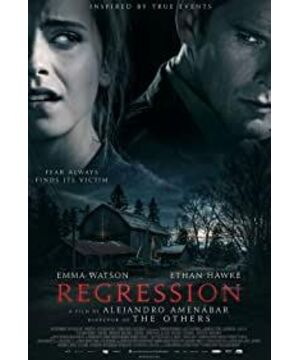If you have lived through the 1980s, you may be able to recall some of the miracles or fears that changed the entire society in those ten years. We want our MTV (Music TV), but we also face the endless threat of nuclear destruction. We think our leggings and weird hairstyles are very sexy, but our faces pale in fright in the face of the growing threat of AIDS.
You might think that our minds are already nervous enough without the help of imagination. Many of us believe that the secret and widespread demon worship is a kind of interference or even torture for the growth of children.
Welcome to the world of Satan's panic. This is the reality that people really felt in the 1980s and early 1990s. The lives of ordinary Americans have fallen into a new situation in the war, struggling between traditional values and demon-like perverted psychology. Not only are helpless young children and vulnerable teenagers in danger, each of us may have faced the torture of Satanic ritual abuse (SRA) in the past-blasphemous sexual rituals are very appalling , I am afraid that only a genius therapist can extract them from our depressed memory.
Satanic panic not only produced images of professional criminology and therapeutic literature, in that era, it spread all over the world within a month, and the mass media were also crazy about it. By the end of the 1980s, this fear had become international, with images spreading across the United Kingdom, Australia, Canada, the Netherlands, and South Africa.
Of course, the devil’s theory was fictitious. Although some people call themselves Satan worshippers, they only appear in the relevant documents of Satan panic, and they have never left their footprints in human history.
From the perspective of sociolinguistics, it is a kind of moral panic—an uneasy mood that is caused by socially-oriented collective fears and spreads like a virus. It is affected by various cultural shocks, such as the media and advocacy organizations. , Religious groups, politicians, novels and word of mouth, etc.
For the time being, think of Satan's panic as a big wildfire. Let us start with cultural factors and explore the behind-the-scenes hands that ignite these flames.
This engraving depicts a child suffering ritual abuse by Satan. This photo is from a 1608 work-Compendium Maleficarum (Compendium Maleficarum)
. The source of Satan's panic.
If there is no secret sect that worships demons and molested children, where did the Satanic panic originate?
To find a comprehensive answer means that an in-depth and cruel inquiry into the entire Western history is necessary, even beyond the topic itself. But we can focus on some of the key factors before the 20th century. They defined the concept of Satanism.
First, let us face reality, each of us lives in a world full of beliefs and values. We all have a specific way of looking at the world, and it is these worldviews that define our place in this complex human society. We live in the world with people who hold the same worldview and are in the same position, and other people become "outsiders." We divide the world into two, except for "us" which is "them".
For a long time, people in the circle of the same ideas, that is, "we", have believed in everything about "them". If necessary, they even let people outside the circle become scapegoats. Since the Christian doctrine mainly focuses on the contradiction between heaven and hell, the supernatural power of referring to "them" as demons has become a common strategy.
Therefore, we can see the "blood sacrifice slander" in the 12th century or earlier-claiming that the Jews would kidnap and murder the children of Christians and use their blood for religious ceremonies on certain Jewish holidays. The blood sacrifice slander of Simon of Trent in 1475 even witnessed the torture of an entire Jewish community. 15 Jewish men were executed for the death of a two-year-old child in Trento, Italy. Anti-Semitism violence and moral panic spread throughout awakened Europe.
Think about the witchcraft persecution in the 15th century. In this name, Europeans tortured and executed thousands of innocent Europeans, claiming that this was to eliminate the threat of witchcraft related to demons. As depicted in the previous woodblock prints, children are also threatened. Ironically, the children were also tried and even executed for witchcraft.
To be sure, neither Jews nor witches killed children in the ceremony, but these moral panics and the historical records from them all contributed to people’s misunderstanding of this secret sect, which became the “outsiders” who later killed children in the eyes of others.
The concept of Black Mass (imitating the Christian Mass to worship Satan) and the witches and demons who participated in the midnight assembly were born out of the perverted imagination of the persecuted and the confession under "torture". These two concepts merged with the tradition of ritual magic that existed at the time in the 19th century, when French romantic artists and writers were fascinated by witchcraft and Satanism.
Until the 1920s, the evil cults that had prevailed in history were rooted in Western culture. However, have these cults perished or are they still passed down in a secret form? We only need to understand the cultural background and social anxiety that ignited the moral panic of the 20th century.
Anton LaVey, the founder of the Church of Satan, presented a small atmospheric magic and ritual to the news media on March 22, 1970. ©Bateman/Corbis
The source of Satanic panic in the 20th century
No matter how vague the description, how unreliable the supernatural details, the historical facts of blood sacrifice and witch trials are irrefutable. To this day, there are still all kinds of perverse descriptions and print art. But obviously, this is not enough. Moral panic can eventually become a climate, what kind of cultural background is needed?
First, let us consider the role of novels. The historian Phillip Jenkins pointed out that Herbert Gorman's 1927 novel "Dagon Temple" had a key influence on the arrival of Satan's panic. Most people today have forgotten that at the time, the demon worship from Salem was both radical and influential. But the purely fictional works only focus on the fascination with witchcraft in the last century, and people at that time used these witchcraft to establish the worship of Satan in contemporary America. The book has attracted many readers and has influenced many inspiring writers, such as HP Lovecraft, Robert Bloch and Dennis Whitley ( Dennis Wheatley).
By the 1930s, the worship of Satan had found its home in vulgar novels and grew up from it. In the horror movies of the 1960s, this theme became more and more popular. More and more people have come to know the cult of Satan because they liked the horror movie "The Devil Rides Out" (The Devil Rides Out) and the popular "Rosemary's Baby" (Rosemary's Baby) in 1968. Since then, the supernatural Satan theme entered the rock music market in the 1970s, followed by heavy metal music. They are all cool, exciting and anti-traditional. They also further promote the worship of Satan.
But this is only a fictional factor before Satan's panic. Now let us consider some real events that contributed to Satan's panic.
Stimulated by the cult worship of the 19th century, Aleister Crowley found support in the media at the Black Mass in London in the 19th century. Americans learn about this strange and scary hedonist and his rituals through reading. In 1966, Anton Ravi’s establishment of the Satan Church in San Francisco attracted more media attention. The church’s doctrine is mainly derived from individualism and atheism. In addition, it also wraps itself with provocative stage-effect evil rituals: black robes, five-pointed stars, candles, and nudes.
Next is the Satan worship factor in real crimes. The material is taken from novels and myths of investigators and criminals. As early as the 1930s, the police were thinking about the motives of offering sacrifices to cults. The murder of the Manson family in 1969 aroused the media’s suspicion of Satan’s motives. The serial killer convicted in 1989, Richard Ramirez, was publicly quoted in his crimes and subsequent trials. The name of Satan. The Devil Slayer has become a reality.
Only a few factors contributed to the panic that followed. What drives things to extremes is an urgent threat to children and ourselves.
In this photo taken in 1990, we see Faye Yager of Atlanta (U.S. city), who established an underground network to protect victims of child abuse and demon worship.
Satan ritual abuses the
15th century witchcraft theorists and interrogators to obtain testimony through intimidation and torture, because the victims’ confession obtained in this way meets their expectations, even exceeds their expectations, and there are grounds for accusing supernatural demons and debauchery. .
So, in the late twentieth century, why did these testimonies still prevail when they were unprovoked? Why interrogate vulnerable young people for granted?
By the late 1970s, child abuse had become a hot topic in the American media. Reports of child kidnapping, child killing, and child pornography arouse public outrage but are also disgusting. Every responsible citizen cannot tolerate it. In 1978, children from the Jonestown Religious Commune died in Guyana (Latin America). This incident makes the boundary between religious activities in real life and fictional Satanism no longer clear.
Later, in 1984, the accusation of sexual assault in McMartin Kindergarten in California and the lengthy trial made contemporary Americans remember "satanic ritual abuse" (SRA). Six years later, the trial resulted in acquittal and dismissal, but this absurd lawsuit did explode in the media. The prosecutor complained that many teachers sexually assaulted hundreds of children in rituals featuring robes, masks, five-pointed stars, and altars.
Numerous cases similar to McMartin’s kindergarten suddenly appeared throughout the United States. Incidents usually start with accusations of actual violations. Then, follow-up investigations often unearth more extensive sexual assault incidents. Every case revolves around the main issues, and every vulnerable child is eager to describe the shocking details appropriately.
By the mid-1990s, in many cases, hundreds of day care workers and parents were accused of sexually assaulting children. There is no doubt: the assault in the cult ritual has evolved into a real crime.
But Satan's panic poses a threat not only to the children of the time, but also to the children of the past. After all, it is no longer a matter of a day or two for such a closely-connected secret cult to target children. Possibly, even your childhood may have been involved in cruel cult rituals. All you need to do is to awaken the memories buried in your heart.
This is why there was a memory regeneration movement in the 1980s to help us understand our panic. Proponents believe that memories of injuries—especially those of sexual assault as a child—may be buried in the subconscious mind. Although these memories are basically forgotten, these emotional fragments will still have a negative impact on your life. The only solution is to let the therapist dig out these memories and treat them with memory recovery therapy (RMT).
This is a very difficult question. Most victims who suffered sexual assault in childhood can at least recall part of the incident. Even the few cases where the entire incident is forgotten can certainly be recalled later-but they can only construct memories that seem to be credible but are far from the truth, or false memories.
Remember, memory is not rooted in stone, its medium is more like soft clay: whenever we extract stored memories, they are very easy to be manipulated by ourselves or others. In fact, Harvard University psychologist Daniel Schacter (Daniel Schacter) identified at least seven factors that affect accurate recall, including the power of suggestion. Fantasy, social environment and cultural images can also whitewash personal memories. Once these memories are created, they are just like the real ones, and it is difficult to erase them again.
The 1980 book "Michelle Remembers" helped consolidate the SRA memory buried in the public perception model. The book was co-authored by Canadian psychiatrist Lawrence Pazder and his patient (who later became his wife) Michelle Smith (Michelle Smith). It describes in detail Smith’s treatment experience: after a certain treatment With her help, she recalled the experience of being tortured and violated for a long time in Vancouver in the 1950s. Although the book was ultimately discredited, it provided a template for the memoirs of many SRA survivors, and it did cause a media sensation at the time.
Maybe you can see the appeal of the recalled SRA memory. What if the problems you encounter in your adult life are caused by deep-seated psychological trauma? If the therapist can extract it from your mind-dig it out of the darkness and face it, what will it be like? Perhaps you can also imagine meeting a kind therapist who is full of enthusiasm to extract these gloomy memories for you, no matter how clever these memories are forged in the cultural context of Satan worship.
As a result, news headlines are flooded with reports of cult rituals and loss of memory. Geraldo Rivera (Geraldo Rivera) launched a special report during prime time in 1988-"Uncovering Satan’s Underground Work" and other TV exposures exhibiting various "expert" therapists, law enforcement veterans, and SRA survivors .
The message is clear: Devil worshippers are all around us, they are keen on ritual violations, and they kill our children in the name of an ancient cult. Out of the safety of our own values and beliefs, we will divert our attention and ultimately blame a lot of pain on the completely non-existent-"outsiders".
West Memphis, the local Stonehenge in Arkansas, once a gathering place for young people is now abandoned, and there are vague Satanic graffiti on the stone.
Satan's panic
Satan's panic did not cause massacre casualties, but the damage it caused is still vivid. Although the demon nature of the "restored" memories violated during the ceremony is false, many people still have to live with these false painful memories. More importantly, as mentioned before, hundreds of day care workers and parents have experienced the trauma of SRA accusations-they were expelled from their families and communities because they were suspected of being connected to a cult.
Then there is pleading guilty. A couple, Frances and Dan Keller, who were suspected of assaulting others while doing day care in Texas, caught a 48-year prison sentence and have now served 21 sentences. year. The accusation also involved young tigers and parrots used for cemetery sacrifices pecking children who were "peeing". This was in 2013, and they were finally released due to lack of evidence and false medical testimony.
The three major cases in West Memphis may be the most famous cases in which Satan's panic witch hunted down. In 1993, three children were killed in West Memphis, Arkansas, and three local youths were eventually convicted. The lawsuit focused on the bloody ceremony. In addition, the 17-year-old suspect Jessie Lloyd Misskelley (Jessie Lloyd Misskelley) provided police officers with confessions about the carnival and animal sacrifices in the woods. In 2011, the three defendants received a 10-year probation and were all released. This action angered the people, who flocked to them, crowding long highways, to protest the investigation and its cultural impact.
However, to a large extent, the fireworks of Satan's panic have died out in the 1990s. In 1994, a study of child abuse and neglect from the National Center destroyed almost every point of SRA’s credibility. A large number of meta-researches have found only a few believed orphan or paired offenders using ritualized strategies to deal with children, and no more than 1/12,000 incidents can provide evidence that they are related to Satan and the cult that sexually assaults children.
The legal case collapsed. No results were obtained from the investigation. Although the American mass media has contributed to spreading the Satanic panic, at least it has also contributed to extinguishing this panic. By the late 1980s, most mainstream news programs began to boycott SRA scripts. From 1990 to 1994, exposing SRA became a new hot topic.
However, could this fire be completely extinguished? Like all embers, the heat of this fire still lingers in the fringe of isolated subcultures and their international expansion. You will still find the pastor condemning the annoying power of the mass media. To this day, the South African Police Service still employs a secret criminal force to counter the threat of Satan in the country.
The moral panic has not gone away. It is part of our human nature. All we can do is to be vigilant at all times and understand the relevant cultural factors to prevent these flames from getting out of control.
Author: Robert Lamb
Article link http://e.edu.163.com/docs/99/2015082116/B1IDCEK99001CEKA.html
View more about Regression reviews











